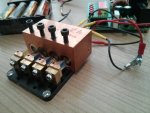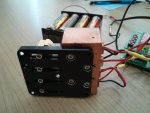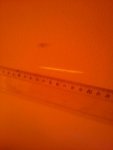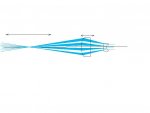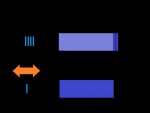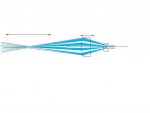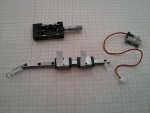- Joined
- Feb 12, 2016
- Messages
- 589
- Points
- 63
This project was inspired by former avatar of Alaskan.
This is my first experience in knife edging of multimode LDs, so I tried to prepare well - last year I asked CDBEAM to make me a Quad Heatsink-Holder for four 12mm DTR modules from a solid block of copper. It should replace the small Al LDs holder in the original Lasertack set because this one for sure would not be good to absorb and evacuate heat produced by four working 6W lasers.
CDBEAM also provided fixing screws for all modules and made additional hole in the micro baseplate to fix this heavy Cu chunk well.
After that I did some add-ons to the set up: made side and bottom holes for set screws to fix the back parts of the DTR modules what allowed me to take advantage of the CDBEAM’s set screws to fix focusing rings. I did this because I did not want to use teflon tape for fixing G-2 barrels in focus to infinity positions. Maybe wrong but we will see…
Finally, I glued the prism mirrors, assembled the device and adjusted the beams with all LDs connected in series at 450mA current. From the 3rd and 4th pictures I suppose that I have knife edged LD1 &2 pretty well (no gap visible), but between LD2, LD3 and LD4 spots there are gaps of ~1mm what I think is due to mount positions (once prism mirrors are glued you cannot move the mounts left-right).
Did I do it right of do I need to try adjusting all four spots so that there would be no gaps between spots at all?
Anyway once adjusted - the spot on the wall at 5m is the line ~6-7cm long. So it does look OK, does not it?
This is my first experience in knife edging of multimode LDs, so I tried to prepare well - last year I asked CDBEAM to make me a Quad Heatsink-Holder for four 12mm DTR modules from a solid block of copper. It should replace the small Al LDs holder in the original Lasertack set because this one for sure would not be good to absorb and evacuate heat produced by four working 6W lasers.
CDBEAM also provided fixing screws for all modules and made additional hole in the micro baseplate to fix this heavy Cu chunk well.
After that I did some add-ons to the set up: made side and bottom holes for set screws to fix the back parts of the DTR modules what allowed me to take advantage of the CDBEAM’s set screws to fix focusing rings. I did this because I did not want to use teflon tape for fixing G-2 barrels in focus to infinity positions. Maybe wrong but we will see…
Finally, I glued the prism mirrors, assembled the device and adjusted the beams with all LDs connected in series at 450mA current. From the 3rd and 4th pictures I suppose that I have knife edged LD1 &2 pretty well (no gap visible), but between LD2, LD3 and LD4 spots there are gaps of ~1mm what I think is due to mount positions (once prism mirrors are glued you cannot move the mounts left-right).
Did I do it right of do I need to try adjusting all four spots so that there would be no gaps between spots at all?
Anyway once adjusted - the spot on the wall at 5m is the line ~6-7cm long. So it does look OK, does not it?
Attachments
Last edited:


